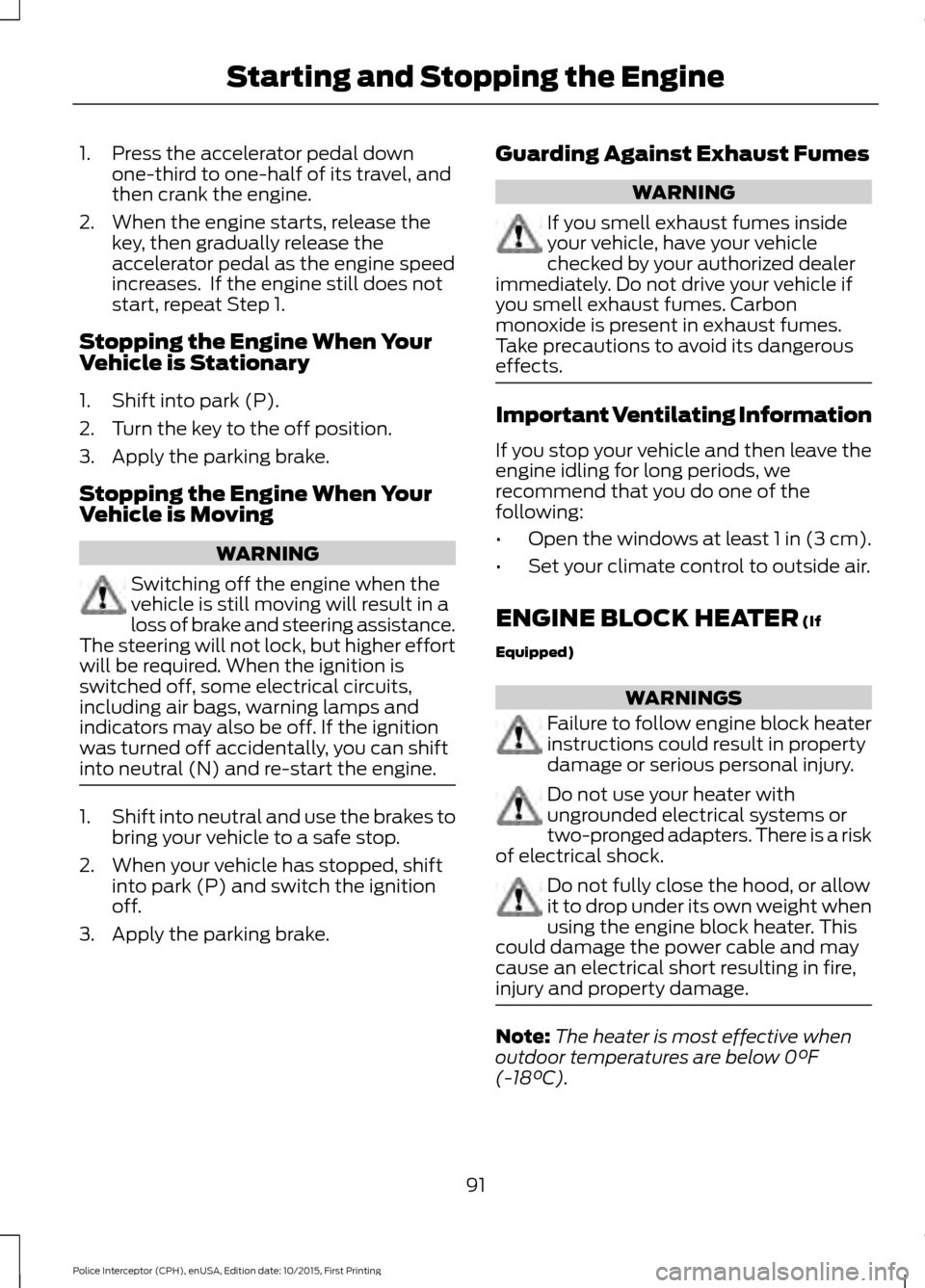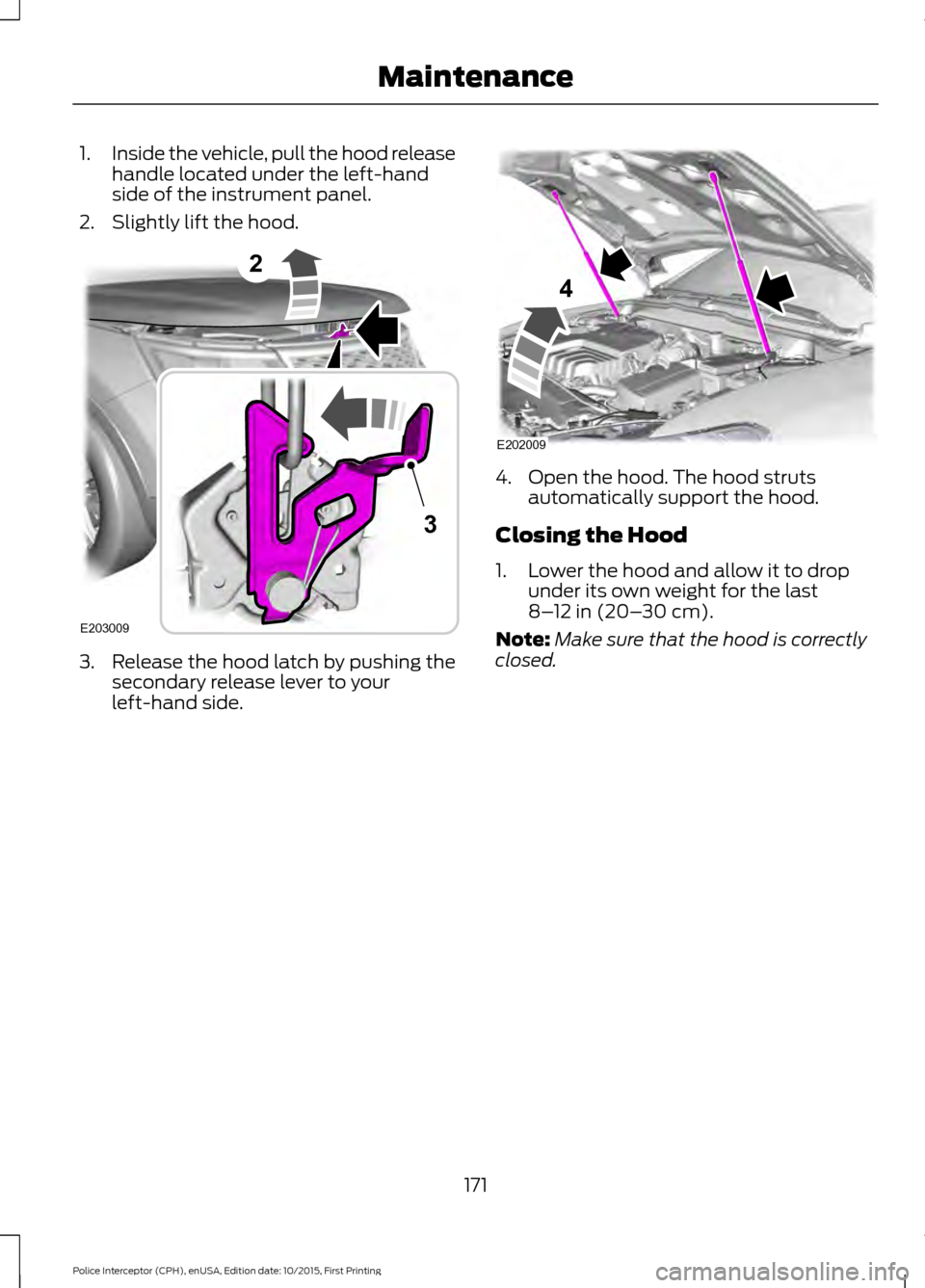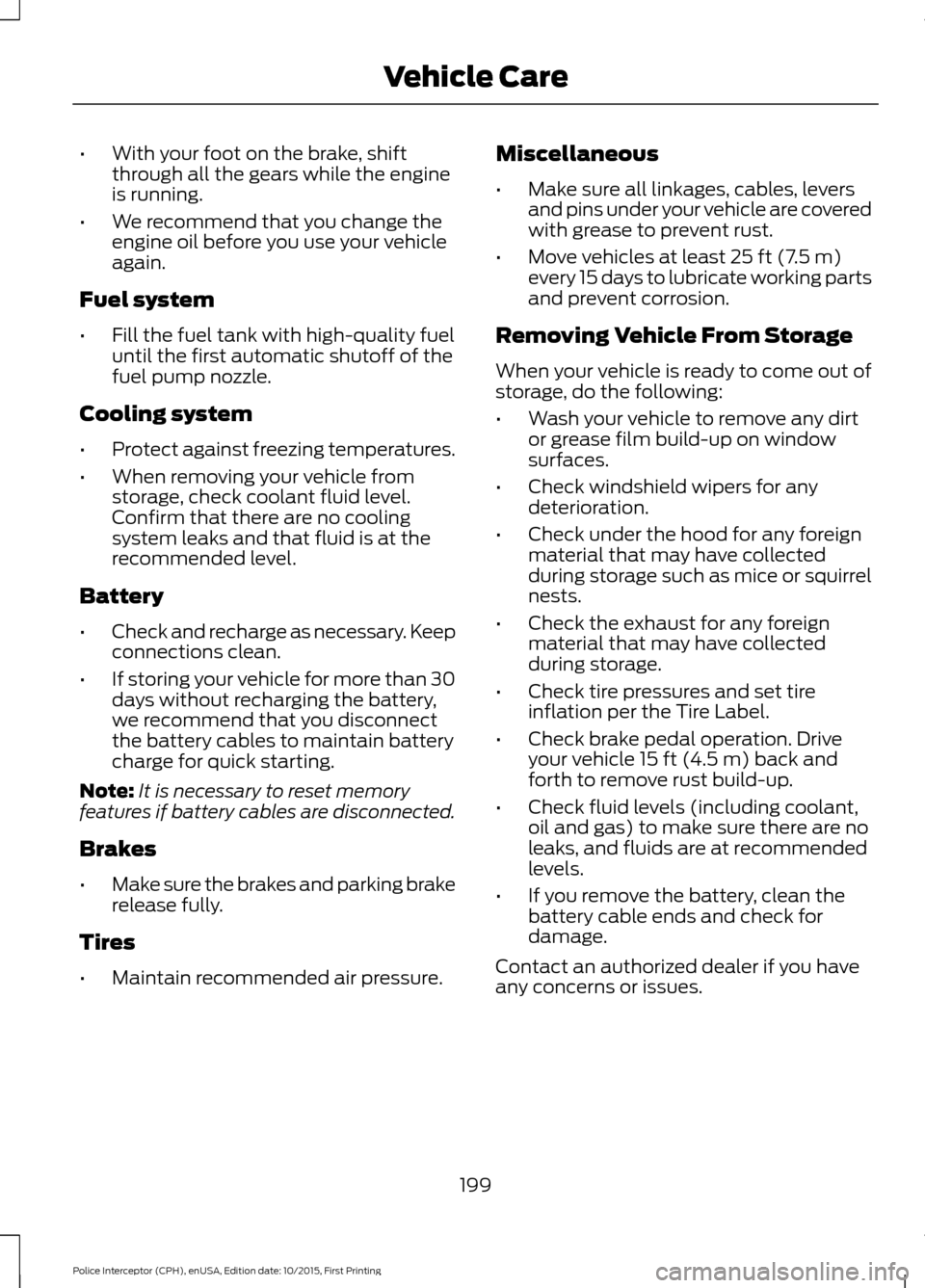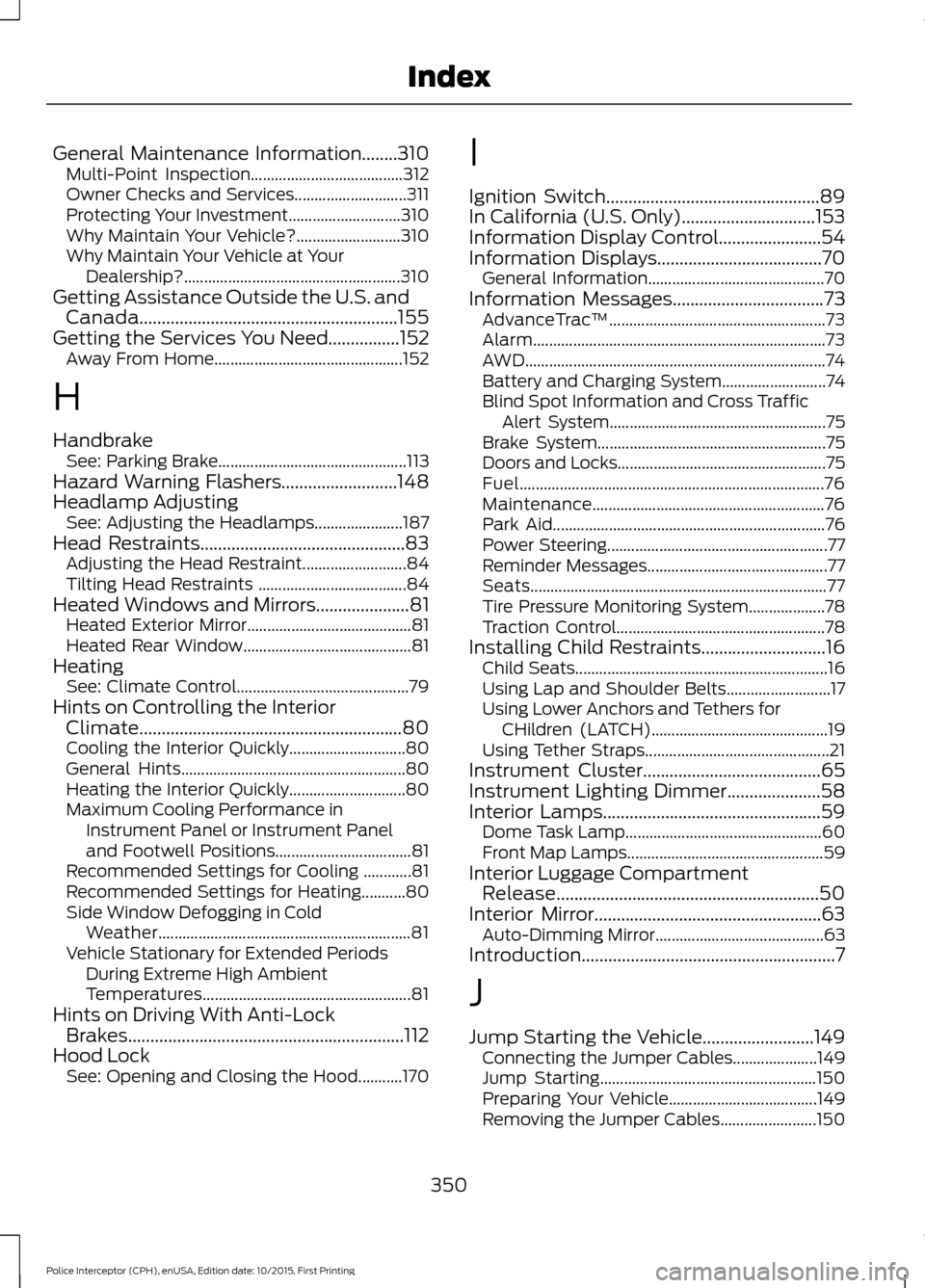2016 FORD POLICE INTERCEPTOR SEDAN hood release
[x] Cancel search: hood releasePage 94 of 358

1. Press the accelerator pedal down
one-third to one-half of its travel, and
then crank the engine.
2. When the engine starts, release the key, then gradually release the
accelerator pedal as the engine speed
increases. If the engine still does not
start, repeat Step 1.
Stopping the Engine When Your
Vehicle is Stationary
1. Shift into park (P).
2. Turn the key to the off position.
3. Apply the parking brake.
Stopping the Engine When Your
Vehicle is Moving WARNING
Switching off the engine when the
vehicle is still moving will result in a
loss of brake and steering assistance.
The steering will not lock, but higher effort
will be required. When the ignition is
switched off, some electrical circuits,
including air bags, warning lamps and
indicators may also be off. If the ignition
was turned off accidentally, you can shift
into neutral (N) and re-start the engine. 1.
Shift into neutral and use the brakes to
bring your vehicle to a safe stop.
2. When your vehicle has stopped, shift into park (P) and switch the ignition
off.
3. Apply the parking brake. Guarding Against Exhaust Fumes WARNING
If you smell exhaust fumes inside
your vehicle, have your vehicle
checked by your authorized dealer
immediately. Do not drive your vehicle if
you smell exhaust fumes. Carbon
monoxide is present in exhaust fumes.
Take precautions to avoid its dangerous
effects. Important Ventilating Information
If you stop your vehicle and then leave the
engine idling for long periods, we
recommend that you do one of the
following:
•
Open the windows at least 1 in (3 cm).
• Set your climate control to outside air.
ENGINE BLOCK HEATER (If
Equipped) WARNINGS
Failure to follow engine block heater
instructions could result in property
damage or serious personal injury.
Do not use your heater with
ungrounded electrical systems or
two-pronged adapters. There is a risk
of electrical shock. Do not fully close the hood, or allow
it to drop under its own weight when
using the engine block heater. This
could damage the power cable and may
cause an electrical short resulting in fire,
injury and property damage. Note:
The heater is most effective when
outdoor temperatures are below 0°F
(-18°C).
91
Police Interceptor (CPH), enUSA, Edition date: 10/2015, First Printing Starting and Stopping the Engine
Page 174 of 358

1.
Inside the vehicle, pull the hood release
handle located under the left-hand
side of the instrument panel.
2. Slightly lift the hood. 3. Release the hood latch by pushing the
secondary release lever to your
left-hand side. 4. Open the hood. The hood struts
automatically support the hood.
Closing the Hood
1. Lower the hood and allow it to drop under its own weight for the last
8–12 in (20– 30 cm).
Note: Make sure that the hood is correctly
closed.
171
Police Interceptor (CPH), enUSA, Edition date: 10/2015, First Printing Maintenance2
E203009
3 E202009
4
Page 202 of 358

•
With your foot on the brake, shift
through all the gears while the engine
is running.
• We recommend that you change the
engine oil before you use your vehicle
again.
Fuel system
• Fill the fuel tank with high-quality fuel
until the first automatic shutoff of the
fuel pump nozzle.
Cooling system
• Protect against freezing temperatures.
• When removing your vehicle from
storage, check coolant fluid level.
Confirm that there are no cooling
system leaks and that fluid is at the
recommended level.
Battery
• Check and recharge as necessary. Keep
connections clean.
• If storing your vehicle for more than 30
days without recharging the battery,
we recommend that you disconnect
the battery cables to maintain battery
charge for quick starting.
Note: It is necessary to reset memory
features if battery cables are disconnected.
Brakes
• Make sure the brakes and parking brake
release fully.
Tires
• Maintain recommended air pressure. Miscellaneous
•
Make sure all linkages, cables, levers
and pins under your vehicle are covered
with grease to prevent rust.
• Move vehicles at least 25 ft (7.5 m)
every 15 days to lubricate working parts
and prevent corrosion.
Removing Vehicle From Storage
When your vehicle is ready to come out of
storage, do the following:
• Wash your vehicle to remove any dirt
or grease film build-up on window
surfaces.
• Check windshield wipers for any
deterioration.
• Check under the hood for any foreign
material that may have collected
during storage such as mice or squirrel
nests.
• Check the exhaust for any foreign
material that may have collected
during storage.
• Check tire pressures and set tire
inflation per the Tire Label.
• Check brake pedal operation. Drive
your vehicle
15 ft (4.5 m) back and
forth to remove rust build-up.
• Check fluid levels (including coolant,
oil and gas) to make sure there are no
leaks, and fluids are at recommended
levels.
• If you remove the battery, clean the
battery cable ends and check for
damage.
Contact an authorized dealer if you have
any concerns or issues.
199
Police Interceptor (CPH), enUSA, Edition date: 10/2015, First Printing Vehicle Care
Page 353 of 358

General Maintenance Information........310
Multi-Point Inspection...................................... 312
Owner Checks and Services............................ 311
Protecting Your Investment............................ 310
Why Maintain Your Vehicle?.......................... 310
Why Maintain Your Vehicle at Your Dealership?...................................................... 310
Getting Assistance Outside the U.S. and Canada..........................................................155
Getting the Services You Need
................152
Away From Home............................................... 152
H
Handbrake See: Parking Brake............................................... 113
Hazard Warning Flashers..........................148
Headlamp Adjusting See: Adjusting the Headlamps...................... 187
Head Restraints
..............................................83
Adjusting the Head Restraint.......................... 84
Tilting Head Restraints ..................................... 84
Heated Windows and Mirrors.....................81 Heated Exterior Mirror......................................... 81
Heated Rear Window.......................................... 81
Heating See: Climate Control........................................... 79
Hints on Controlling the Interior Climate...........................................................80
Cooling the Interior Quickly............................. 80
General Hints........................................................ 80
Heating the Interior Quickly............................. 80
Maximum Cooling Performance in Instrument Panel or Instrument Panel
and Footwell Positions.................................. 81
Recommended Settings for Cooling ............81
Recommended Settings for Heating...........80
Side Window Defogging in Cold Weather............................................................... 81
Vehicle Stationary for Extended Periods During Extreme High Ambient
Temperatures.................................................... 81
Hints on Driving With Anti-Lock Brakes..............................................................112
Hood Lock See: Opening and Closing the Hood...........170 I
Ignition Switch
................................................89
In California (U.S. Only)..............................153
Information Display Control.......................54
Information Displays
.....................................70
General Information............................................ 70
Information Messages
..................................73
AdvanceTrac ™...................................................... 73
Alarm........................................................................\
. 73
AWD
........................................................................\
... 74
Battery and Charging System.......................... 74
Blind Spot Information and Cross Traffic Alert System...................................................... 75
Brake System......................................................... 75
Doors and Locks.................................................... 75
Fuel........................................................................\
.... 76
Maintenance.......................................................... 76
Park Aid.................................................................... 76
Power Steering....................................................... 77
Reminder Messages............................................. 77
Seats........................................................................\
.. 77
Tire Pressure Monitoring System................... 78
Traction Control.................................................... 78
Installing Child Restraints
............................16
Child Seats............................................................... 16
Using Lap and Shoulder Belts.......................... 17
Using Lower Anchors and Tethers for CHildren (LATCH)............................................ 19
Using Tether Straps.............................................. 21
Instrument Cluster........................................65
Instrument Lighting Dimmer
.....................58
Interior Lamps.................................................59 Dome Task Lamp................................................. 60
Front Map Lamps................................................. 59
Interior Luggage Compartment Release...........................................................50
Interior Mirror...................................................63 Auto-Dimming Mirror.......................................... 63
Introduction.........................................................7
J
Jump Starting the Vehicle
.........................149
Connecting the Jumper Cables..................... 149
Jump Starting...................................................... 150
Preparing Your Vehicle..................................... 149
Removing the Jumper Cables........................ 150
350
Police Interceptor (CPH), enUSA, Edition date: 10/2015, First Printing Index